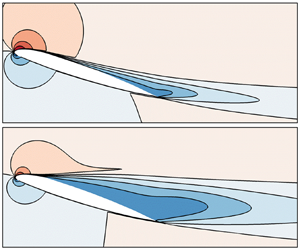Article contents
Bifurcation scenario for a two-dimensional static airfoil exhibiting trailing edge stall
Published online by Cambridge University Press: 04 October 2021
Abstract

We numerically investigate stalling flow around a static airfoil at high Reynolds numbers using the Reynolds-averaged Navier–Stokes equations (RANS) closed with the Spalart–Allmaras turbulence model. An arclength continuation method allows to identify three branches of steady solutions, which form a characteristic inverted S-shaped curve as the angle of attack is varied. Global stability analyses of these steady solutions reveal the existence of two unstable modes: a low-frequency mode, which is unstable for angles of attack in the stall region, and a high-frequency vortex shedding mode, which is unstable at larger angles of attack. The low-frequency stall mode bifurcates several times along the three steady solutions: there are two Hopf bifurcations, two solutions with a two-fold degenerate eigenvalue and two saddle-node bifurcations. This low-frequency mode induces a cyclic flow separation and reattachment along the airfoil. Unsteady simulations of the RANS equations confirm the existence of large-amplitude low-frequency periodic solutions that oscillate around the three steady solutions in phase space. An analysis of the periodic solutions in the phase space shows that, when decreasing the angle of attack, the low-frequency periodic solution collides with the unstable steady middle-branch solution and thus disappears via a homoclinic bifurcation of periodic orbits. Finally, a one-equation nonlinear stall model is introduced to reveal that the disappearance of the limit cycle, when increasing the angle of attack, is due to a saddle-node bifurcation of periodic orbits.
Information
- Type
- JFM Papers
- Information
- Copyright
- © The Author(s), 2021. Published by Cambridge University Press
References
REFERENCES
- 15
- Cited by


